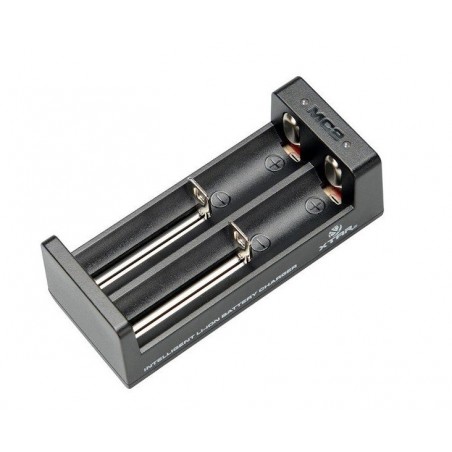





Professional processor charger for Li-ion cells in sizes 14500, 14650, 16340, 17500,17670, 18350, 18500, 18650, 18700, 20700, 21700, 22650, 25500, 26650
three-stage charging method: TC / CC / CV
two independent charging channels
reactivation of deeply discharged cells and 0V cells
charging current: 0.5A
charging voltage: 4.2V
powered by micro USB - no power adapter included
protections: thermal, short-circuit, against reverse battery insertion
Professional, dual-channel, compact processor charger
Xtar MC2
for Li-ion batteries in size 18650 and others
• two independent charging channels • powered by any micro USB charger or from a computer USB port (min. 0.5A) • small dimensions - easy to carry • function of reactivating deeply discharged cells • protections: short-circuit, thermal, against reverse polarity |
A fully professional processor charger with a three-stage charging process is hidden in a small housing TC / CC / CV. Charges 1-2 3.6 / 3.7V Li-ion cells of any capacity in sizes 14500, 14650, 16340, 17500, 17670, 18350, 18500, 18650, 18700. It is also possible to charge one battery size 20700, 21700, 22650, 25500 or 26650.
What is the TC / CC / CV charging method? It is a three-stage process of charging Li-ion cells to keep the cell in good condition by charging the appropriate current at each stage and completing the charging process at the right moment.
The various stages of the TC / CC / CV process are:
• TC phase: cells discharged below 2.85V are 'woken up' with a lower current.
• CC phase: after reaching 2.85V, the cell is charged with a constant current of 0.5A or 0.25A (depending on the power source used).
• CV phase: when the cell is almost charged, the charger switches to charging with decreasing current until reaching a voltage of 4.2V on the cell. After reaching 4.2V, the charging process is complete - the battery is fully charged.
Batteries with a voltage of 4.1V or higher are considered by the charger as charged. To fully charge such a battery, insert it into the charger before connecting it to the power supply. Charged batteries will naturally discharge when left in the charger. Charging will resume when the battery voltage drops below 4.1V.
Charger Xtar MC2 has the function of reactivating deeply discharged cells and cells with a voltage of 0V. Many chargers on the market are unable to charge such batteries. This is where the charger comes in Xtar MC2which in many cases allows for the 'recovery' of such links. Just insert the deeply discharged battery into the MC2 charger, just like with normal charging - the charger detects the discharged cell and attempts to reactivate it. Warning! Cells discharged below a certain level will be irreparably damaged and may not be reactivated. Avoid deeply discharging Li-ion batteries - this may significantly reduce their life and capacity, or lead to their complete failure.
Chargers from other manufacturers can significantly increase the temperature of the cells being charged during charging. If the cells become too hot, they may wear out faster. When designing the MC2 charger, Xtar went one step further from the competition, solving this problem in a simple way: it was powered by an external power supply. As a result, the temperature of the battery charged in the MC2 will increase by no more than 15 degrees.
Complete with charger Xtar MC2 we get a micro USB cable and a cover securing the charger for transport. The set does not include the power adapter. To power the charger, any charger with a micro USB cable, e.g. from a phone, or a USB socket, or a computer with a free USB port is enough. The recommended charger power is 1A (1000mA).
| Product data | |
| manufacturer | Xtar |
| charger model | MC2 |
| supported battery types | 1-2 Li-ion batteries 3.6 - 3.7V, protected and unprotected |
| battery sizes supported | 10440, 14500, 14650, 16340, 17500,17670, 18350, 18500, 18650, 18700, 20700, 21700, 22650, 25500, 26650 |
| maximum battery length | 70mm |
| input voltage i input current | 5V 500mA - 1000mA |
| power socket | micro USB |
| power adapter included | NO |
| recommended power adapter | minimum 5V 0.5A, recommended 5V 1A |
| charging method | processor controlled TC / CC / CV |
| charging current in the CC phase | 250 or 500mA ± 50mA (depending on the power source used) |
| termination voltage charging | 4.2V ± 0.05V |
| termination current | |
| additional functions | reactivation of deeply discharged cells and 0V cells |
| security | thermal, short circuit, before inserting the battery upside down |
| dimensions | 92 x 40 x 32mm |
| weight | 42g |
| kit contents | MC2 charger, micro USB cable |